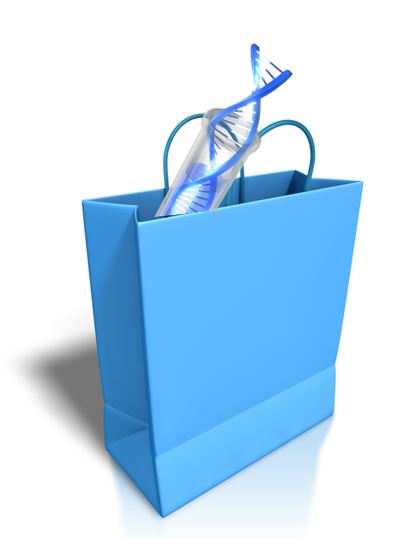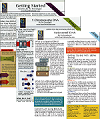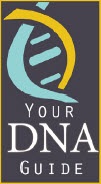by | Mar 22, 2015 | 01 What's New, DNA, Jewish
 A direct-to-consumer genetic test, the first of its kind to be approved in the U.S., may become available through 23andMe, according to letters recently received by 23andMe customers. The FDA-approved test is designed to check to see if you are a carrier for Bloom Syndrome, a disease most common among those of Jewish heritage.
A direct-to-consumer genetic test, the first of its kind to be approved in the U.S., may become available through 23andMe, according to letters recently received by 23andMe customers. The FDA-approved test is designed to check to see if you are a carrier for Bloom Syndrome, a disease most common among those of Jewish heritage.
This is a huge step for 23andMe, which lost the ability to report health related information to its U.S. customers in November of 2013 and has been working to restore it ever since. Health testing for 23andMe customers is currently underway in Canada and the UK. This is the first big step toward restoring the health component of their testing to those of us in the U.S.
This kind of direct to consumer (DTC) testing is going to be a huge industry. For those of you with any experience getting a genetic test ordered and executed through your doctor’s office, you know this process can be lengthy, not to mention very expensive.
As more and more genetic tests are able to be offered directly to you via commercial companies, there will be more competition for this kind of test, meaning that there will be more research conducted into the cheapest way to produce this kind of test. Since these are the same kinds of procedures used for our genetic genealogy testing, more research and lower costs for DTC tests means cheaper genetic genealogy tests.
In further news, 23andMe announced their intention to enter the pharmaceutical industry and begin to develop medicines to address some of the diseases and conditions it has engineered genetic tests to identify. This is a good reminder that a company we have previously lumped with the other two purely genetic genealogy companies (Ancestry and Family Tree DNA) is very much a medically-minded company.
While 23andMe does provide information regarding your ancestral heritage and provides a list of genetic cousins, it is important to realize that this company’s interest in your family tree is focused more on your family’s ailments than its ancestors. (Click here to read a Forbes article about this development, and click here for more information about the laws that are in place to protect your genetic data, including health testing.)
 Are you ready to get started with DNA testing for genealogy, or to get expert help in interpreting the tests you’ve already done? I can help! I’m “Your DNA Guide.” Consider starting with my series of genetic genealogy cheat sheets in the Genealogy Gems store:
Are you ready to get started with DNA testing for genealogy, or to get expert help in interpreting the tests you’ve already done? I can help! I’m “Your DNA Guide.” Consider starting with my series of genetic genealogy cheat sheets in the Genealogy Gems store:
- Getting Started
- Mitochondrial DNA
- YDNA, Autosomal DNA
- Using AncestryDNA
- Using FamilyTreeDNA
And visit my website to learn more my consulting services.
by Lisa Cooke | Nov 13, 2014 | 01 What's New, Ancestry, DNA, Gifts, Records & databases
 Savvy shopping can save you money and time. So what does savvy DNA shopping look like? Genetic genealogy tests–yDNA, autosomal and mDNA–do require a financial investment. They aren’t cheap. But they can save you hours of traditional research and give you results that no paper trail may provide.
Savvy shopping can save you money and time. So what does savvy DNA shopping look like? Genetic genealogy tests–yDNA, autosomal and mDNA–do require a financial investment. They aren’t cheap. But they can save you hours of traditional research and give you results that no paper trail may provide.
Three main companies are currently selling autosomal DNA tests (that’s the test that is not limited to a direct maternal or a direct paternal line, and that can help you find genetic cousins with connections back as far as six or seven generations). Those three companies, 23andMe.com, DNA Ancestry and Family Tree DNA are all competing for you genetic genealogy dollar. All offer a good service, and it can be difficult to decide who to give your $99 to.
and Family Tree DNA are all competing for you genetic genealogy dollar. All offer a good service, and it can be difficult to decide who to give your $99 to.
When your success or failure in finding matches depends entirely on who else has also been tested, it would be nice to have a crystal ball to tell you which testing company has the most participants who are useful to your research. FTDNA has no crystal ball, but they now are offering a reasonable substitute: FREE access to their database for anyone who has test results from 23andMe (if you received results before November of 2013) and AncestryDNA . Yes, I said FREE!
. Yes, I said FREE!
There are conditions. You can see your first 20 matches (but they can’t see you), and try out some of the tools that FTDNA has to help you identify how you are related to others. To have full access to the tools and results, you can pay $38, or just recruit four of your family members or friends to transfer, and then your transfer is FREE.
So, if you have been tested by Ancestry or 23andMe, run, don’t walk, to transfer your Y-DNA results to Family Tree DNA and take a look inside their version of the crystal ball. If you haven’t “done DNA” yet, currently the best option is to be tested with AncestryDNA and then transfer to FTDNA.” (watch for holiday sales, which would probably drop the price to $79). This gives you access to TWO databases of potential relatives for around $110–if you are a savvy shopper!

Final DNA shopping tip: be an educated consumer! Check out these quick guides I wrote to help genealogists find and use the DNA products that will help their research. Purchase each guide individually or pick up all 4 for the best deal!
Visit my website to learn about expert consultations with me. You’ll get customized guidance on which tests to order and how to maximize your results for your genealogy research.
by | Oct 25, 2014 | 01 What's New, DNA, MyHeritage
 This just in: Genealogy and family networking giant MyHeritage just announced a partnership with personal genetics company 23andMe. Here we share highlights from a press release, followed by comments from Your DNA Guide here at Genealogy Gems, Diahan Southard:
This just in: Genealogy and family networking giant MyHeritage just announced a partnership with personal genetics company 23andMe. Here we share highlights from a press release, followed by comments from Your DNA Guide here at Genealogy Gems, Diahan Southard:
“We have some breaking news today at MyHeritage – we’ve just announced an important new collaboration and product integration between MyHeritage and leading personal genetics company 23andMe….

23andMe pioneered autosomal DNA analysis, which can find relatives across all ancestral lines, and has built the largest autosomal DNA ancestry service in the world. MyHeritage’s 5.5 billion global historical records, 1.5 billion family tree profiles in 27 million family trees and innovative matching technologies, combined with 23andMe’s DNA analysis, will provide users with an integrated and enhanced experience to uncover their family history.
Combining documented genealogy – family trees, family stories and family memories – with DNA-based ancestry is the next evolution in family history research. While DNA testing can find relatives from shared ancestors, it’s the family trees and historical records that are critical to fully map and understand these connections….”
Hmmm….what to make of this? Diahan Southard comments:
 “The announcement of the collaboration between 23andme and My Heritage is definitely good news for genealogists. This proves that influential genealogy companies and popular genetics companies are recognizing that genetic genealogy is a team buy ear mite medication sport. We need both genetics and traditional genealogical methods to tell the full story of our ancestry. I think this is a move that both companies needed to make in order to face the increased competition from competitors.
“The announcement of the collaboration between 23andme and My Heritage is definitely good news for genealogists. This proves that influential genealogy companies and popular genetics companies are recognizing that genetic genealogy is a team buy ear mite medication sport. We need both genetics and traditional genealogical methods to tell the full story of our ancestry. I think this is a move that both companies needed to make in order to face the increased competition from competitors.
It also shows that the genetic genealogy industry is nearly bursting with new ideas and new collaborations, which means more innovation and more competition, ultimately leading to a better experience for us as genealogists as we try to integrate DNA testing into our research.
While the details of the collaboration are thin, we will watch anxiously over the next few months to learn how integrated the two companies will become, and then we can determine the best ways to use the tools of both to fill in the holes in your family tree.”
Read more about the collaboration and product integration between MyHeritage and 23andMe in a MyHeritage blog post or watch the video below where MyHeritage Founder and CEO, Gilad Japhet, break the news live on Bloomberg TV earlier today.
 Want to learn more about DNA? Check out Your DNA Guide Diahan Southard’s series of laminated quick reference guides to genetic genealogy:
Want to learn more about DNA? Check out Your DNA Guide Diahan Southard’s series of laminated quick reference guides to genetic genealogy:
by Lisa Cooke | Jan 7, 2014 | 01 What's New, Ancestry, DNA, Family History Podcast, FamilySearch, Organization, Photographs

No episode! But lots of good updates. Keep reading….
UNLUCKY Episode 13: Genetic Genealogy and Photo Sharing
Episode 13 of the original podcast reviewed genetic genealogy and photo sharing products that are either now longer offered or are outdated. This episode is not being republished with the series.
Fortunately, lots of advances have been made in both genetic genealogy services and photo sharing and tagging, and we’ve got lots of current resources for you.
Genetic Genealogy (DNA)
Start here where you’ll find answers to common questions, a free introductory video, and additional DNA resources
Next, listen to my interview with Dr. Turi King, who used DNA to identify King Richard III. That interview is on my Premium Podcast (available by subscription) and talks about what DNA can tell us–and what it can’t.
Another interview you might enjoy is with Bennett Greenspan from Family Tree DNA, featured in Premium Podcast Episode 92.
 (Not a Premium Member? Check out all the great membership benefits–including members-only premium podcast episodes, full access to the premium podcast archive for an entire year, video recordings of some of my most popular classes and even premium videos that teach you some of the most important skills for 21-st century genealogists.)
(Not a Premium Member? Check out all the great membership benefits–including members-only premium podcast episodes, full access to the premium podcast archive for an entire year, video recordings of some of my most popular classes and even premium videos that teach you some of the most important skills for 21-st century genealogists.)
Free Photo Sharing Resources
Flickr
Photobucket
In addition, remember that Ancestry.com, FamilySearch.org, MyHeritage.com and other genealogy sites have excellent photo-sharing services for those who don’t mind sharing their images with the public.
by Lisa Cooke | Dec 18, 2013 | 01 What's New, DNA
I recently blogged about some governmental red tape being faced by 23andMe. They have suspended sales of their “health-related genetic tests” and stopped providing interpretive information about those tests, but are continuing to offer their genealogy products. Just thought I’d share!
 A direct-to-consumer genetic test, the first of its kind to be approved in the U.S., may become available through 23andMe, according to letters recently received by 23andMe customers. The FDA-approved test is designed to check to see if you are a carrier for Bloom Syndrome, a disease most common among those of Jewish heritage.
A direct-to-consumer genetic test, the first of its kind to be approved in the U.S., may become available through 23andMe, according to letters recently received by 23andMe customers. The FDA-approved test is designed to check to see if you are a carrier for Bloom Syndrome, a disease most common among those of Jewish heritage. Are you ready to get started with DNA testing for genealogy, or to get expert help in interpreting the tests you’ve already done? I can help! I’m “Your DNA Guide.” Consider starting with my series of genetic genealogy cheat sheets in the Genealogy Gems store:
Are you ready to get started with DNA testing for genealogy, or to get expert help in interpreting the tests you’ve already done? I can help! I’m “Your DNA Guide.” Consider starting with my series of genetic genealogy cheat sheets in the Genealogy Gems store:







 (Not a Premium Member?
(Not a Premium Member? 


